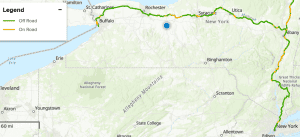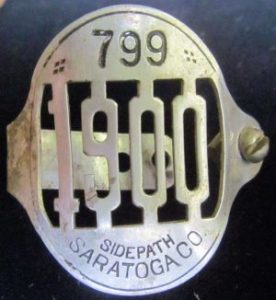Bicycles and Cinder Paths, Part 2
By John Marks, Curator of Collections
Last month I began the story of my interest in cinder, or side, paths. I left off in 1897 with the Geneva-Waterloo path that was never completed on the Geneva end. While path building didn’t take off in this city, it grew elsewhere in the area and state.
The January 13, 1898 Geneva Gazette reported on a pending bill in the state legislature.
“The number of bicyclists in the State of New York and their weights in the community may be inferred from the fact that the Legislature this winter will be called on to enact a uniform ‘side path’ law.” Each county would have a side path commission to build and maintain paths and issue bike licenses. The licenses, no more than one dollar, would fund the work. Only licensed riders were allowed to ride the paths.
The next notice I found was in the Geneva Daily Times of May 1, 1899, about creating a side path commission for Ontario County. Fifty or more “wheelmen” needed to sign and present a petition to a county judge, who would appoint commissioners. “It is important that the side path commission for this county be appointed at an early date, so that the work of constructing side paths may be at once begun. Once the commission for this county is named, wheelmen residing in this city may use the Seneca county paths by virtue of their Ontario county license.” Without, Genevans had to buy a Seneca County tag. “This would be decidedly inconvenient for Geneva cyclists, as during the summer months the wheel travel between this city and Cayuga Lake park is considerable.”
On the right is an image from the Internet of a side path tag that was attached to the bike frame. If you have one for Ontario or Seneca counties and never knew what it was, please contact us! We’d love to see it and accept it for our collection if you wished to donate.
There was an Ontario County commission by August 1899. County wheelmen fees bought a sod cutter and cinder roller. Materials and labor cost $90 per mile “of first class sidepath.” Side paths near towns were paid for by local tag fees. Geneva’s share built a mile of path to Oaks Corners, and the city commissioners hoped more cyclists would help pay to complete it.
The Daily Times of August 31, 1899 wrote, “West of Geneva the cyclists display much more interest than here in sidepath building. Paths are completed nearly to Victor, with the exception of Geneva’s end of it.”
Side path tags weren’t a formality, they were enforced. The Geneva Advertiser of May 8, 1900 reported, “Seneca County officers are after all wheelmen and women who are caught riding on the cinder path and who are not possessed of the official bicycle tag. Geneva parties must get the tag or stay away from Seneca Co.”
A headline in the April 14, 1904 Geneva Daily Times summed up the end of the side path era in general –
Sidepath Matter a Dead Issue, So it Would Appear From Local Viewpoint….No tags have been received for 1904 and to all appearances nothing will be done to improve the sidepaths in this county this year, especially in the neighborhood of Geneva….For the past few years the interest in wheeling has been dying out, and as a result the local commissioners have not been able to sell enough sidepath tags to pay the regular expenses, [let alone] improving or building new paths.
 The side path idea was revived in the late 20th and 21st centuries. Former rail beds were converted to recreational paths. Today, the Empire State Trail has 750 miles of off- and on-road biking. With several exceptions, one can bike from Buffalo to Albany without competing with cars.
The side path idea was revived in the late 20th and 21st centuries. Former rail beds were converted to recreational paths. Today, the Empire State Trail has 750 miles of off- and on-road biking. With several exceptions, one can bike from Buffalo to Albany without competing with cars.
This article was brought to you in part by our supporters. Be our partner in telling Geneva’s stories by becoming a Historic Geneva supporter.

